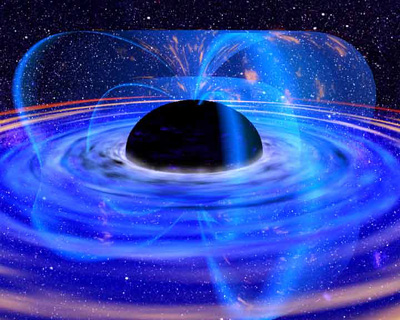Imagine the Universe News - 24 October 2001
Energy "Escapes" Black Hole to Heat Nearby Space
| 24 October 2001 |
Have you ever seen an old-fashioned locomotive chugging into a railway station with its powerful wheels screeching to a halt, sending out sparks and heating the rails?
An international team of scientists have found evidence of a spinning black hole doing much the same. As the spin of this black hole slows, the surrounding region grows hotter with friction. Sparks fly in the form of X-ray light.

|
| Artists conception of matter swirling around a black hole, both in the accretion disk and captured by the magnetic field. |
So, surprisingly, scientists now say that black holes aren't necessarily one-way streets; yes, matter and energy pour into the void, yet other forms of energy can also come back out. The two-way black hole that scientists have recently spotted resides in the core of a galaxy named MCG-6-30-15, about 100 million light years from Earth. With a mass of 100 million suns, this spinning black hole is one powerful locomotive. Yet strong magnetic fields surrounding the black hole seem to apply a "clutch," slowing it down.
The magnetic fields might actually wrap about the black hole, according to Dr. Joern Wilms of Tuebingen University in Germany, the lead scientist on the observation. "The gravity in this region appears to be so intense that the very fabric of space twists around the black hole, dragging magnetic field lines along with it," he said.
This tugs at the black hole, slowing it down, although not completely stopping it from spinning. Wilms and his team reached this conclusion from studying the type of X-ray radiation emitted from near the black hole.

|
|
Animation showing the slowing of the rotation of the black hole
and the resultant build-up of hot gas just outside the black hole. (Click on image to start video 704 KB) (Description) |
Using the European Space Agency's XMM-Newton satellite, the team observed the X-ray glow of iron gas traveling about half the speed of light very close to the event horizon, the theoretical border of a black hole. XMM-Newton captured the spectrum, or chemical fingerprint, of this gas.
The iron spectrum from this black hole has extremely broad "spikes," an indication of gravity tugging at the particles of light, called photons, literally stretching the light. The MCG -6-30-15 black hole's iron line was so broad, in fact, that the bulk of the light must emanate from very close to the black hole, where the force of gravity is the greatest, according to Dr. Christopher Reynolds, a co-investigator on the observation at the University of Maryland, College Park. Gas often glows in X-ray radiation under the crushing force of gravity near a black hole. The greater the gravitational force and the denser the gas, the brighter the X rays. The X rays from MCG-6-30-15, however, are too bright to be explained merely by the effect of gravitational force, Reynolds said. Something around MCG-6-30-15 is boosting the luminosity of what little gas is orbiting the black hole. Mitchell Begelman of the University of Colorado said we may be witnessing the Blandford-Znajek effect, developed in the late 1970s. According to this theory, rotational energy can escape from the black hole as it is braked by magnetic fields. The first law of thermodynamics (conservation of energy) states that the lost energy from a decelerating black hole spin has to go somewhere -- in the case, to the gas in the region surrounding the black hole.
Begelman said the energy lost in MCG-6-30-15 is transferred to the inner edge of the orbiting gas (called the accretion disk), and the magnetic field lines are the conduits. This friction boosts the luminosity, making the hot gas even hotter.
Although magnetic fields have the MCG-6-30-15 black hole (and us) in their grips, don't expect the black hole to stop spinning anytime soon. Reynolds estimates that would take hundreds of billions of years, assuming that the magnetic fields even last that long.

